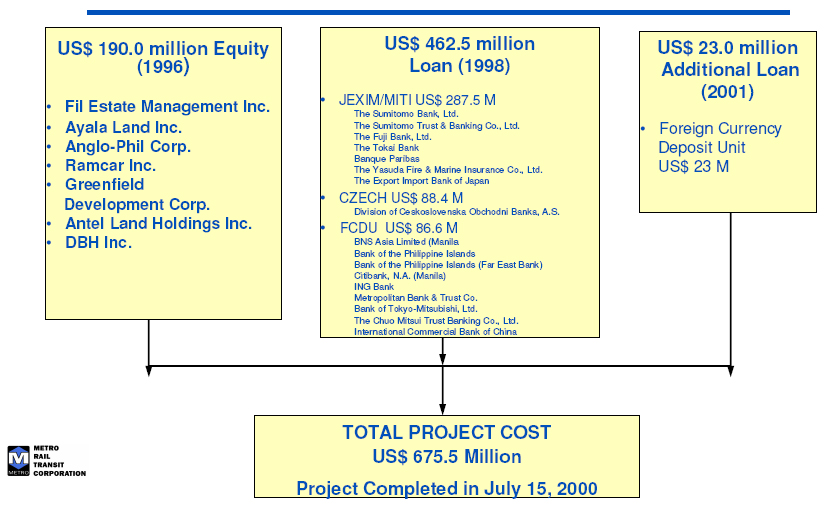Metro Rail Transit Corporation
This article needs additional citations for verification. (December 2021) |
 | |
| Formerly | EDSA LRT Corporation, Ltd. |
|---|---|
| Type | Private |
| Founded | 1995 |
| Founder | Robert John L. Sobrepeña |
| Headquarters | Renaissance Tower, Meralco Avenue, Ortigas Center, Pasig City, Philippines |
Key people | Robert John L. Sobrepeña (Chairman) Frederick Parayno (President) Rafael Perez De Tagle (Director) |
| Website | MRTC Website |
The Metro Rail Transit Corporation (MRTC), is a private consortium organized in June 1995. The consortium is composed of seven (7) Filipino-owned companies: Fil-Estate Management Inc, Ayala Land Inc, Ramcar Inc of National Book Store, Greenfield Development Corporation of Unilab, Anglo-Philippine Holdings Corporation, Allante Realty and Development Inc, and DBH Inc. The Metro Rail Transit Corporation owns the Manila Metro Rail Transit System Line 3 running along the EDSA corridor. MRTC was the original contractor for the EDSA MRT-3 Project. It runs the MRT-3 in coordination with the Department of Transportation under a 25-year Build-Lease-Transfer contract or BLT Agreement, which will end in 2025.
History[]
The MRT Line 3 project, originally known as the EDSA LRT-3 project, was planned by the then-Department of Transportation and Communications (later the Department of Transportation in 1989. A letter of intent was submitted by Eli Levin of Eli Levin Enterprises, Inc. to the DOTC in 1990, under a build-operate-transfer scheme. Eli Levin incorporated EDSA LRT Corporation Ltd. (ELCL), a Hong Kong-based consortium consisting of ten foreign companies.[1]
The bidding for the EDSA LRT III project started in February 1991. Out of five companies that participated in the pre-bidding round, ELCL was the only company that met the requirements. On July 16, 1991, ELCL submitted a proposal for the EDSA LRT III project. The DOTC and ELCL signed a build-lease-transfer agreement on November 7. A revised and restated BLT agreement was signed on September 22, 1992. Under the new agreement, the EDSA LRT III project will be covered in two phases: Phase 1 spans 16 kilometers (9.9 mi) from North Avenue in Quezon City until Taft Avenue in Pasay, while Phase 2 spans 5.5 kilometers (3.4 mi) from North Avenue to Monumento, eventually meeting up with the LRT Line 1.[2] Phase 2, however, was shelved by the Arroyo administration in 2001 in favor of the 5.7-kilometer (3.5 mi) LRT Line 1 North Extension.
In June 1995, a newly formed consortium of reputable Philippine companies purchased an 85% stake in ELCL through EDSA LRT Holdings, Inc. (ELHI), a Philippine-registered company. ELHI also formed and owned MRT Development Corporation (MRT DEVCO), which acquired the development and commercial rights to develop the 16-hectare depot site and the 13 stations.[1] MRTC was formed for the purpose of designing, constructing, testing, commissioning, and maintaining the MRT Line 3.
In December 1995, ELCL's name was changed to Metro Rail Transit Corporation Ltd. ("Metro Rail") and ELHI was correspondingly renamed MRT Holdings, Inc.[citation needed]
Construction of the EDSA MRT-3 project began on October 15, 1996. A revised build-lease-transfer agreement was signed on August 7, 1997. An amended turnkey agreement was later signed on September 16, 1997, with a consortium of companies (including Mitsubishi Heavy Industries and Sumitomo Corporation). A separate agreement was signed with ČKD Dopravní Systémy (ČKD Tatra, now part of Siemens AG), the leading builder of trams and light rail vehicles for the Eastern Bloc, on rolling stock. MRTC also retained the services of ICF Kaiser Engineers and Constructors to provide program management and technical oversight of the services for the design, construction management, and commissioning.[3]
From September 1995 to March 2002, MRTC oversaw the construction, financing and operational management of the project. JP Morgan and the management team of MRTC negotiated with the support of a team of technical experts and other advisors in arranging project financing totaling US$675.5-million from the Japan Bank for International Cooperation (formerly Japan Export-Import Bank or JEXIM), Investiční a poštovní banka, a consortium of Foreign Currency Deposit Unit (“FCDU”) banks led by Citibank, Bank of the Philippine Islands, Far East Bank, ING Bank, Metrobank and the Philippine Government under a Sovereign credit basis whose blended all-in financing cost amounted to only 4.72% p.a. over the entire life of the loan facilities. On October 17, 1997, MRTC obtained financial closure of the loans for the project.[2]
On December 10, 1997, a maintenance agreement was signed between MRTC, Sumitomo Corporation, and Mitsubishi Heavy Industries. Under the agreement, the maintenance provider will provide maintenance and repair services for a period of ten years for the MRT Line 3.[4]
On December 15, 1999, the section of the MRT Line 3 from North Avenue to Buendia was inaugurated,[5] with the line being fully operational on July 20, 2000.[2] MRTC was obligated to lease the system to DOTC, who would operate the system, with MRTC providing the maintenance. DOTC was required to make payments of Rental Fees to Metro Rail, and these were broken down into several different portions. One significant part was intended to repay the loans taken out to finance the project. The responsibility of the maintenance of the system, however, was transferred from the MRTC to the DOTC in 2010.
Plans to buy out the MRT-3 from MRTC to the government were initiated, but this was not pursued.[6]
In 2012, MRT Line 3 (MRT-3) Philippines received a barrage of complaints from loyal passengers due to severe lack of support and maintenance from its administrators. Technical problems became more and more frequent due to old outdated facilities, lack of additional trains, lack of technical knowledge, decaying rails and the train itself. A senator quoted, "People have to wait for one hour just to get inside a cramped broken train". A fare hike was also pushed in 2015 almost doubling the fare cost for commuters with the intention of collecting additional revenues to fund the improvement of its services.[7]
Project Funding Components[]
A breakdown of the key funders and tranche funding components of the MRT-3 Phase-1 Project were as follows:

See also[]
References[]
- ^ a b "RESOLUTION - DIRECTING THE APPROPRIATE SENATE COMMITTEES TO CONDUCT AN INQUIRY IN AID OF LEGISLATION INTO THE OWNERSHIP, CONTROL AND OPERATION OF THE METRO RAIL TRANSIT III PROJECT (MRT3) WITH THE END IN VIEW OF ENACTING LEGISLATIVE MEASURES TO ADDRESS THE SAME" (PDF). January 25, 2011. Retrieved December 20, 2021.
- ^ a b c "About Us". Metro Rail Transit Corporation. Retrieved December 20, 2021.
- ^ "About". dotrmrt3.gov.ph. Retrieved December 20, 2021.
- ^ Marcelo, Elizabeth (January 14, 2016). "DOTC at fault for 'inefficient' maintenance providers, letting MRTC off the hook —COA". GMA News. Retrieved December 20, 2021.
- ^ "Miracle rail project to rid Edsa of jams". New Straits Times. The New Straits Times Press (M) Bhd. December 15, 1999. Retrieved December 20, 2021 – via Google News Archive.
- ^ Desiderio, Louella (December 6, 2015). "DOTC to pursue buyout of MRT-3". The Philippine Star. Retrieved December 20, 2021.
- ^ "LRT-MRT FARES TO BE INCREASED ON JAN.4". Department of Transportation and Communications (DOTC). Archived from the original on December 25, 2014. Retrieved December 20, 2021.
External links[]
- Official MRT-3 website, archived October 15, 2016 at the Wayback Machine
- Department of Transportation (Philippines)
- Transportation companies of the Philippines
- Companies based in Manila
- Rail transportation in Metro Manila